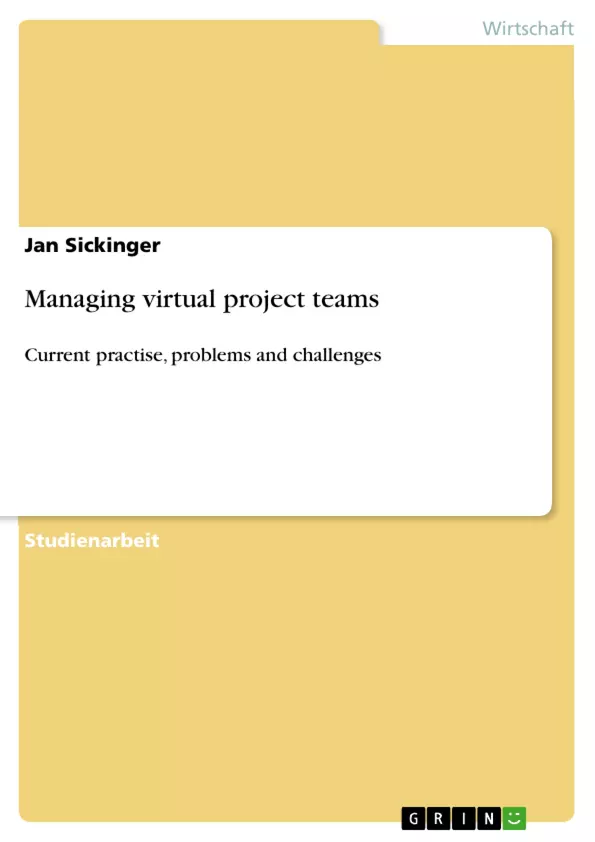While a project is a form of organisation which is characterised through its uniqueness,
its novelty and a fixed end date, a virtual project team is distributed over different
locations worldwide, but working together as one team. Remote communication
between the team members is done through synchronous and asynchronous means of
virtual communication. Because these media cannot transmit the full bandwidth of
human communication, there must be rules set how to act with these different means of
virtual communication in order to prevent frustration and communication problems.
Additional difficulties may arise when a virtual project team is composed of people with
different cultural backgrounds. In such a case, a project manager of a virtual team has to
join communication skills with intercultural skills.
In order to work together under these circumstances, team building is crucial to make a
virtual project a success. Successful team building in a virtual project first of all means
that people with the right characteristics have to be chosen to form a virtual project
team. For example, they must have a high level of self-organisation and social
competence. Furthermore, building trust is crucial in order to make people who may
never see each other in real life successfully work together.
In order to manage the task of a virtual project, a project manager of such a team needs
a high level of social skills coupled with the skills of a motivator.
The Blended Delivery model of Logica, a global provider of IT services, where a local
core team works together with an extended virtual team, may be a good compromise
between virtual and non-virtual project work and may combine benefits of both
organisation forms.
Inhaltsverzeichnis
- Executive summary
- Table of Contents
- List of Abbreviations
- List of Figures
- List of Tables
- 1 Introduction
- 2 Methodology
- 3 Definitions
- 3.1 What is a project?
- 3.2 What is project management?
- 3.3 What is a virtual project team?
- 4 Motivations for forming a virtual project team
- 5 Challenges and problems of a virtual project team and how to overcome them
- 5.1 Difficulties of remote communication and how to deal with them
- 5.2 Dealing with different cultures
- 5.3 Issues of team building
- 5.3.1 Choosing the right people
- 5.3.2 Creating identification
- 5.3.3 Building trust
- 5.3.4 Dealing with conflicts
- 6 Qualities of a virtual project manager
- 7 Current practice: Logica's Blended Delivery model combining virtual and non-virtual aspects as example
Zielsetzung und Themenschwerpunkte
Die vorliegende Arbeit befasst sich mit der Thematik virtueller Projektteams und untersucht die Herausforderungen, Probleme und Chancen dieser Organisationsform. Der Fokus liegt dabei auf den spezifischen Anforderungen, die sich aus der räumlichen Distanz der Teammitglieder ergeben, sowie auf den Möglichkeiten und Strategien, diese Herausforderungen zu bewältigen.
- Herausforderungen der Remote-Kommunikation in virtuellen Projektteams
- Interkulturelle Aspekte und Zusammenarbeit in virtuellen Teams
- Team-Building-Strategien für virtuelle Projektteams
- Führungsqualitäten von virtuellen Projektmanagern
- Beispiele für bewährte Praktiken und Modelle in der virtuellen Projektmanagement
Zusammenfassung der Kapitel
Die Arbeit beginnt mit einer Einführung in das Thema virtuelle Projektteams und definiert grundlegende Begriffe wie Projekt, Projektmanagement und virtuelle Teams. Anschließend werden die Motivationen für die Bildung virtueller Teams beleuchtet.
Im Hauptteil der Arbeit werden die Herausforderungen und Probleme von virtuellen Projektteams im Detail betrachtet. Die verschiedenen Aspekte der Remote-Kommunikation werden analysiert und Lösungsansätze vorgestellt. Außerdem werden die besonderen Schwierigkeiten im Umgang mit kulturellen Unterschieden in virtuellen Teams untersucht.
Ein weiterer Schwerpunkt liegt auf der Thematik des Team-Buildings in virtuellen Umgebungen. Die Arbeit behandelt die Auswahl geeigneter Teammitglieder, die Förderung von Identifikation und Vertrauen innerhalb des Teams sowie die Bewältigung von Konflikten.
Abschließend werden die Anforderungen an virtuelle Projektmanager beleuchtet und ein konkretes Beispiel für die erfolgreiche Anwendung von virtuellen Teams in der Praxis vorgestellt.
Schlüsselwörter
Virtuelle Projektteams, Remote-Kommunikation, Interkulturelle Zusammenarbeit, Team-Building, Projektmanagement, Führungsqualitäten, Blended Delivery Model.
- Quote paper
- Jan Sickinger (Author), 2010, Managing virtual project teams, Munich, GRIN Verlag, https://www.grin.com/document/178003



